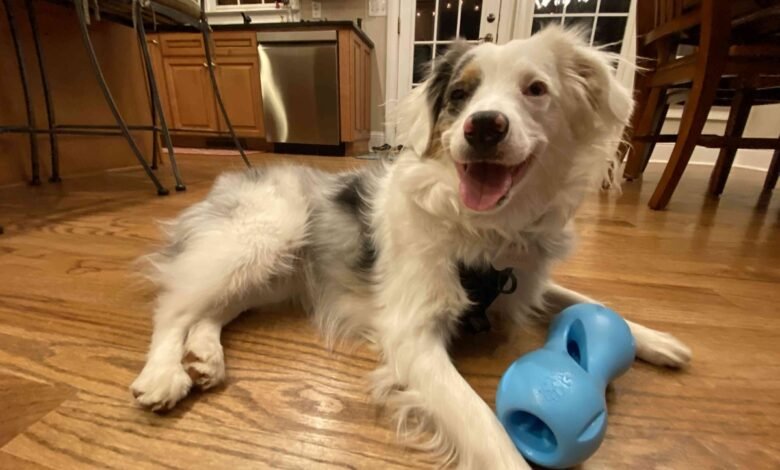
How to Pick the Best Chew Toys for Puppies
When choosing the best and safest puppy teething toys, you should think about your puppy’s age, breed, size, personality, and the stage at which its teeth are coming in.
One of the best ways to keep your new puppy happy and make the move into your home easier is to give it lots of puppy teething toys that are right for its age. Chew toys can keep your puppy busy, out of trouble, and active.
Here’s how to choose the best toys for your puppy to chew on and when to give them to him.
What Are the Best Chew Toys for Puppies 4-24 Weeks Old?
So when can you give a puppy a toy to chew on? Here’s a list of dates to help you plan.
Birth to 12 Weeks Old: No Puppy Teething Toys are Needed
Even though puppies may start to get their first teeth when they are 4 weeks old, this is usually not a time when they need toys or other things to do besides hanging out with their mom and littermates.
From weeks 4 to 12, more of the baby’s (deciduous) teeth come in. Even at this age, most puppies won’t need toys to help them cut their teeth. This is usually the time when puppies stop drinking their mother’s milk and start eating soft puppy food. These tiny teeth can be very sharp, but they aren’t usually very strong. If a puppy plays with a toy meant for an older dog, it can easily damage its teeth.
12 to 24 Weeks Old: Peak Puppy Teething Time
The baby teeth start to fall out between 12 and 24 weeks, and they are replaced by permanent teeth. This is the busiest time for teething. It’s usually the worst time for puppies and the most frustrating for their owners.
It’s important to get your puppy toys that will help with the pain of teething and keep it from chewing on your furniture, shoes, toes, or even your other pets. Chew toys made for puppies should also be right for your puppy’s size, breed, and how much he or she likes to chew.
Nylabone puppy teething toys, like the Nylabone teething rings or the Nylabone teething pacifier, are great for puppies because they have raised nubs on the surface that massage the gums as puppies chew.
Even at this age, KONG Puppy toys are good because they can be filled with treats and frozen. Their gums are numbed and soothed by the cold. KONG makes a variety of teething toys for puppies that come in different sizes based on breed and body weight. Be careful not to give a small KONG to a bigger puppy that might swallow it by accident.
Also, toys that are more durable or tough (like the KONG Puppy Teething Stick) should be saved for more aggressive chewers and bigger breeds of puppies.
Which Puppy Teething Toys Fit Your Puppy’s Personality?
When choosing the best chew toys for your puppy, you may also want to think about the following:
- Do they have a lot of downtime in their crate or personal space? (distraction toys)
- How active is your puppy? Do they enjoy rough-and-tumble play with their housemates? (action toys)
- Do they seem shy or anxious around new people or in new situations? (comfort toys)
The answers will help you figure out whether distraction toys, action toys, or comfort toys are best for your dog.
Distraction Toys (Rubber Treat-Holding Toys)
Puppy toys that can also be used to help a puppy cut its teeth are great for when its owners aren’t home and the puppy is alone.
People like toys that can hold food or treats, like the classic KONG rubber toys, which also come in a special KONG Puppy version made of softer rubber for puppies’ teeth and gums. These can be filled with treats and even frozen so that they provide enrichment and rewards over a long period of time.
Puzzle toys, like the Pet Zone IQ Treat Dispenser, will keep puppies busy as they try to “unlock” the treat inside. These toys are not for teething, but they will keep puppies busy.
Read More: How long can I leave my pet alone?
Action Toys (Fetch and Rope Toys)
Action toys are great for dogs that can’t sit still for long. These toys aren’t your typical “teething toys for puppies,” but they meet a dog’s need to play and chew at the same time.
Fetch Toys
Fetch toys are some of the best toys for active play. These are great for daily exercise, trips to the dog park, or trying to burn off that extra puppy energy at the end of the day.
Tennis balls can help puppies get exercise and learn to fetch, but they can be dangerous if too much of the felt on the outside is eaten or if the rubber center is chewed through and broken up. You should only let your kids play with tennis balls when you are watching.
For puppies, the ChuckIt! Ball Launcher is a good choice. ChuckIt! tennis balls have a thicker rubber core that makes it harder for dogs to chew them up. ChuckIt! also makes tennis balls in different sizes for dogs of different sizes.
A very big dog The ChuckIt! the ball may be too hard for the teeth of small-breed puppies, so make sure to follow the breed size guidelines on the package and don’t let puppies chew on the toys for too long or play with them alone (this can be said of any toy, really).
Rope Toys
You and your puppy can also play a gentle game of tug-of-war with rope toys, and they can also satisfy your puppy’s need to chew. Be careful not to pull the tug rope too hard or let your puppy hang from the end of it. Not only could you get hurt, but you also don’t want to teach the dog to be aggressive or to “stay away.”
Rope toys should be reserved for older, larger breed puppies/young adult dogs whose permanent teeth have erupted. Young puppies (under 12 weeks of age) are more likely to sustain injuries to their teeth, jaws, and neck if tug-of-war play is too aggressive. Teeth could accidentally be pulled out, and the neck and jaw are vulnerable to injury when puppies are still developing.
Rope toys should be made of durable material, such as strong cotton fibers that are tightly braided and unlikely to unravel. Some rope toys are designed for durability because they have knots that prevent unraveling in long strands.
Rope toys that fray and unravel easily can cause harm to puppies if they ingest long strands. Once swallowed, the strands could cause an obstruction in the stomach or intestine. Loose strands can also get tangled around the base of the tongue, which can cause a strangulation-type injury to the tongue itself.
Comfort Toys (Soft Plush Toys)
Soft, plush toys are ideal for younger puppies that have not developed their full chewing potential and are not likely to destroy the toy. They’re best for small-breed or orphaned puppies, puppies under 12 weeks of age, or puppies that have anxiety issues and need a calming outlet.
Comfort toys can serve as snuggle-buddies for sleeping or as replacement nurses for puppies who were weaned from their mom too young. GoDog and KONG Cozies have a wide variety of soft critter companions to choose from.
Care should be taken when choosing the perfect plush toy to make sure that they:
- Are sewn well with reinforced seams
- Have no dangling ribbons, tags, or loose plastic parts that can be easily chewed off and swallowed (stuffed animal eyes and noses are often favorite targets for chewers) (stuffed animal eyes and noses are often favourite targets for chewers)
Toys with squeakers or bells inside should be checked regularly for damage, as these parts can be swallowed and cause intestinal blockage.







